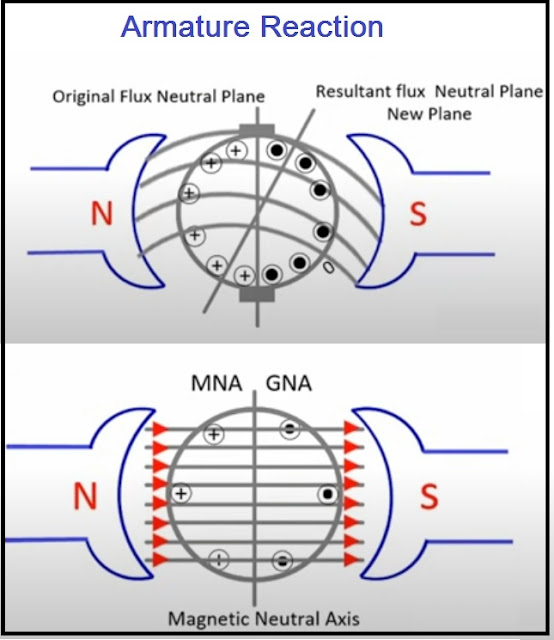To understand What is armature reaction, it is important to first understand the basic principles of generator and motor operation. In a generator, the armature windings are rotated within a stationary magnetic field, which induces a voltage in the windings and produces an electrical output. In a motor, the opposite is true: a current is applied to the armature windings, which creates a magnetic field that interacts with the magnetic field of the machine to produce a rotational force.

When current flows through the armature windings, it produces its own magnetic field. This field interacts with the main magnetic field of the machine, causing a distortion in the field lines. The result is a shift in the location of the magnetic neutral axis (MNA), which is the point at which the main magnetic field is perpendicular to the armature winding.
The displacement of the MNA causes several effects on the performance of the machine. One of the most significant effects is the reduction of the machine's voltage output. This occurs because the voltage generated in the armature winding is proportional to the rate at which the magnetic field is cut by the winding. When the MNA is shifted, the rate of magnetic field change is reduced, resulting in a lower voltage output.
Another effect of armature reaction is the creation of a magnetic field component that is perpendicular to the main field. This component is known as the cross-magnetizing field and can cause several problems in the operation of the machine. For example, it can lead to increased eddy current losses in the machine's core, which can cause overheating and damage to the machine. It can also lead to increased torque ripple in a motor, which can result in uneven mechanical loads and decreased efficiency.
Nullify Armature Reaction in DC Machine
To mitigate the effects of armature reaction, several techniques are used. One common technique is to adjust the excitation of the machine's field windings to compensate for the shift in the MNA. This technique is known as commutation, and it is used in many types of machines, including DC motors and generators. Another technique is to use special winding configurations that reduce the effects of armature reaction, such as the use of interpoles in DC machines. This winding produces a magnetic field that opposes the effects of the armature reaction, effectively canceling them out. This method is commonly referred to as the "interpoles" or "commutation poles" method.
Another method to nullify the effects of armature reaction is to use a brushless DC motor (BLDC). In a BLDC motor, the armature windings are replaced by a set of permanent magnets, which eliminates the need for brushes and commutation. This design reduces the effects of armature reaction and improves the motor's efficiency, reliability, and performance.
Nullification of the effects of armature reaction in DC motors is essential for maintaining the motor's performance and efficiency. The most common methods for nullification include the use of compensating windings in the field poles and the use of brushless DC motors.
In conclusion, armature reaction is a complex phenomenon that occurs in electric machines when current flows through the armature windings. It can have significant effects on the performance of the machine, including reduced voltage output, increased eddy current losses, and torque ripple. However, with proper design and control techniques, these effects can be minimized, allowing for efficient and reliable operation of electric machines.
FAQ
What is Armature Reaction?
Armature reaction is a phenomenon that occurs in an electric generator or motor when current flows through the armature windings. It refers to the interaction between the magnetic field produced by the armature current and the main magnetic field in the machine.
What is Geometrical neutral axis?
The geometrical neutral axis is an imaginary line that passes through the center of the pole shoes in a DC machine. It is perpendicular to the magnetic flux lines and is the axis of the armature coil where there is no net emf induced when the armature rotates in the magnetic field.
What is Magnetic Neutral axis?
The magnetic neutral axis is the axis of the armature where there is no change in the magnetic flux density when the armature rotates in the magnetic field. It is the axis where the armature flux is equal and opposite to the main field flux, resulting in zero net magnetic flux.
Effects of Armature reaction?
- Demagnetization of the poles due to the distortion of the magnetic field
- Reduced terminal voltage due to the voltage drop across the armature resistance and reactance
- Changes in the speed-torque characteristics of the machine
- Unbalanced magnetic forces on the rotor, which can cause mechanical vibrations and noise
- Interference with the commutation process, leading to poor commutation and sparking.









Please accept my sincere appreciation for your superb work. It is quite astounding how well you are able to explain complex ideas in your writing, which is faultless. It has been a tremendous pleasure for me to read your work; I've gained a lot of knowledge and seen things from fresh angles.
ReplyDeleteIf you're interested in purchasing robotic parts, please click here.
dc drive controller